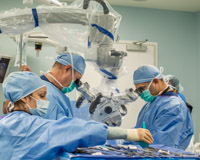An Analysis of 1043 Patients Undergoing Cervical Artificial Disc Replacements in an Ambulatory Surgery Center.
Author: Steven Girdler, MD
Abstract:
Introduction: Artificial Disc Replacement (ADR) is a common procedure used to treat spinal stenosis, disc degeneration, and disc herniation in the cervical spine traditionally performed in the inpatient setting. ADRs can be completed as a single level procedure, in which a single cervical disc is replaced, two levels, three levels, or more. In recent years, there has been a shift from performing ADRs in an inpatient setting to an outpatient setting, allowing for reduced hospital stays, quicker recovery times, and significant cost reductions. This retrospective analysis evaluates the efficacy, safety, and cost-effectiveness of outpatient single and multi-level outpatient ADR, comparing data from patients in a single outpatient setting between 2018 and 2024.
Methods: We conducted a retrospective review of data collected from patients who underwent outpatient ADR at a single institution between 2018 and 2024. Data were collected from a surgical scheduling database, HST case coordination, and exported into Excel Version 16.92 for analysis.
Results: The study included 1043 patients, with 84 performed in 2018, 97 in 2019, 142 in 2020, 206 in 2021, 173 in 2022, 205 in 2023, and 136 in 2024. Demographic data, ASA classifications, surgical times, patient outcomes, and costs were reviewed. The cohort consisted of 443 females, 599 males, and 1 undisclosed. ASA scores were used to assess patient health status, with 429 being classified as ASA 1, 561 as ASA 2, 39 as ASA 3, and 14 undocumented. Three different classifications of surgeries were determined: single level, two level, and three level ADR. Surgical times ranged from 18 to 215 Minutes. Single level ADRs ranged from 18 to 215 minutes with an average surgical time of 69.82 minutes, two levels ranged from 24 to 202 minutes with an average surgical time of 93.41 minutes, and three level ADRs ranged from 75 to 211 minutes with an average surgical time of 131.77 minutes. The average surgical time for all level ADRs was 84.74 minutes with little variation across age groups. Post-operative complications and hospital readmissions were also assessed. No patients required hospital transfer or postoperative blood transfusion in the immediate perioperative period prior to discharge from the outpatient facility. All patients were discharged within 24 hours.
Conclusion: The shift toward outpatient from inpatient care demonstrates potential for substantial cost savings, reduced hospital stays, and fewer resource utilizations. These results demonstrate the success of ADRs with minimal complications within the immediate postoperative period. Outpatient ADR is an effective and cost-efficient approach to for spine surgery traditionally performed in the inpatient setting. Reduced hospital stays, minimal complications, and significant cost savings compared to traditional inpatient models highlight the evolving landscape of spine surgery. Progression toward outpatient spine surgery is a favorable alternative to inpatient procedures by improving patient recovery and offering financial benefits. Further prospective studies are needed to validate these findings and expand usage of outpatient spine surgeries across various procedures.

About the author
discmdgroup DISC Sports & Spine Center (DISC) is a national leader in minimally invasive spine surgery, orthopedic surgery, and sports medicine care. Our spine surgeons set the standard in artificial disc replacement, spine fusion, discectomy, microdiscectomy and the full spectrum of spine procedures. The group’s orthopedic surgeons advance the state of joint preservation surgery and total joint replacement, including total knee replacement as well as total hip replacement. Our flagship surgery centers based in Newport Beach, Marina del Rey, and Carlsbad serve patients local to Los Angeles, Orange County and San Diego, as well as the rest of the country. Read more articles by discmdgroup.




